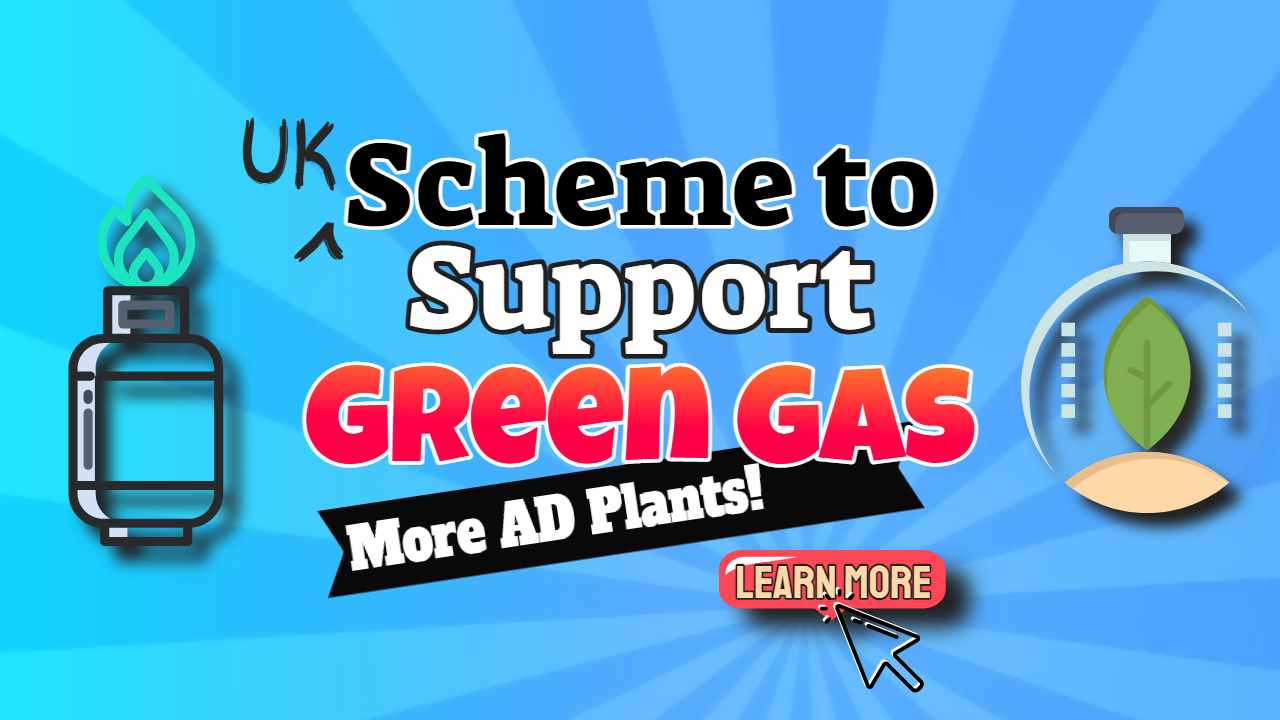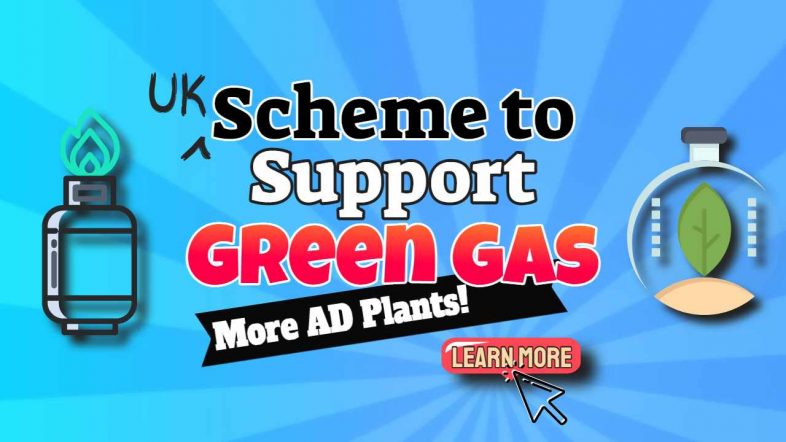We explain how the UK scheme to support Green Gas will help build new UK Biomethane capacity at a cost to citizens of less than £5 to average Annual Energy Bills. It replaces the RHI (Renewable Heat Incentive).
Why is the UK Government Supporting Green Gas?
The aim of the UK's Green Gas Support Scheme is to more than quadruple the output of this gas (biomethane) from anaerobic digestion plants which produce biogas which is upgraded to biomethane and compressed to gas grid quality.
In fact, it's hoped that it will incentivize biomethane projects that will provide enough gas to heat 200,000 houses that would have been heated by natural gas otherwise.
New UK Biomethane Capacity
Carbon emission reduction budgets 4 and 5 over the years 2023-2032 (to targets agreed during COP26), will save 3.7 million tonnes of CO2 equivalent emissions, and 8.2 million tonnes in total by the time the plan ends in 2040-41.
It will also provide 1,600 jobs each year while new factories are being built, and up to 1,000 employment once they are fully operating. The vast majority will be in rural regions.
“By supporting this investment in new anaerobic digestion capacity, we aim to encourage more employment, development, and innovation in the biomethane industry, as well as significant carbon reductions, which are critical to attaining our overall net-zero ambitions,”
said Lord Callanan.

On This Page
- Government Announces Details of the Green Gas Support Scheme
- Limited Green Gas Supply
- Green Gas Support Scheme and Green Gas Levy
- The Green Gas Support Scheme (GGSS)
- The Green Gas Levy (GGL)
- Consultation on the Green Gas Levy
- The Green Gas Support Scheme (GGSS) Announced via a Levy on Licensed Gas Suppliers
- Hydrogen and Biomethane the Green Gas Support Scheme
- Conclusion
Government Announces Details of the Green Gas Support Scheme
 Lord Callanan claimed this week that a system that would charge energy companies to support the building of “green gas” biomethane facilities will add just £2.50 per year to home energy bills at first, peaking at under £5 per year.
Lord Callanan claimed this week that a system that would charge energy companies to support the building of “green gas” biomethane facilities will add just £2.50 per year to home energy bills at first, peaking at under £5 per year.
The Green Gas Support Scheme (GGSS), according to Lord Callanan, Parliamentary Under-Secretary of State at the Department for Business, Energy and Industrial Strategy (BEIS), will help decarbonize the UK's heavily polluting heating sector, which currently accounts for 21% of our greenhouse gas emissions.
The green gas support scheme is now launched and will be funded by a green gas levy. Green gas levy. In its consultation on the green gas levy, the government proposes that gas suppliers will be levied at a flat rate per meter they supply.
It is anticipated that gas suppliers will pass on the cost of the levy to their customers. The £5 per year estimate is based on that assumption
The Green Gas Support Scheme, which was announced in the March 2020 budget, will begin collecting levy payments from gas suppliers in April 2022.
Limited Green Gas supply
Biomethane “green gas” is a renewable gas produced through the anaerobic digestion of food and other organic wastes. The quantity produced is limited to the amount that the UK's circa 700 anaerobic digestion plants can produce.
Domestic green energy suppliers back the use of grid-injected biomethane, but there is not enough to go around. For example, Good Energy has announced that 6 per cent of its green gas supply is made up of biomethane injected into the grid.
Companies like Good Energy supply this “green gas” to their customers after the same quantity has been injected into the gas grid somewhere else, contributing to the decarbonization of the gas supply.
In the UK, the Green Gas Certification Scheme (GGCS) is the main registry for Renewable Gas Guarantee of Origin certificates (RGGOs), dealing with 80% of the total liquidity. It will be a long while yet if ever before there is enough “green gas” (biomethane) is produced.
Green Gas Support Scheme and Green Gas Levy
 Lord Callanan predicted that the effect on yearly gas expenses would be “quite minor,” commencing at roughly £2.50 per metre point per year. But, with natural gas prices due to rise massively over the next 12 months even this increase will be unpopular. It has already been dubbed “the Green Gas Levy”.
Lord Callanan predicted that the effect on yearly gas expenses would be “quite minor,” commencing at roughly £2.50 per metre point per year. But, with natural gas prices due to rise massively over the next 12 months even this increase will be unpopular. It has already been dubbed “the Green Gas Levy”.
Because of the original per metre technique, all customers' yearly expenditures will be the same, implying that household users would pay more per kilowatt-hour (kWh) than those with higher usage profiles, such as enterprises.
Annual gas price rises, on the other hand, will be “quite inexpensive,” according to Lord Callanan, starting at roughly £2.50 per metre point each year.
Because of the original per metre technique, all customers' yearly expenditures will be the same, implying that household users would pay more per kilowatt-hour (kWh) than those with higher usage profiles, such as enterprises.
The green gas support scheme (GGSS) was announced by BEIS (the UK Department for Business, Energy, and Industrial Strategy) and will be administered by Ofgem.
It will be funded by a supplementary levy on licensed gas suppliers and will come into force from April 2022 (although those putting biomethane into the grid will be able to claim from Autumn 2021) and will last for four years before a further scheme is put in place.
The green gas levy was announced in the UK governments March 2020 budget and will be the funding source for the green gas support scheme (GGSS).
The GGSS will replace the non-domestic renewable heat incentive (RHI) scheme which is due to come to an end in April 2021.
The Green Gas Support Scheme (GGSS)
The new Green Gas Assistance Scheme will be funded by the UK's green gas tax, which was announced in the March 2020 budget and would provide support for biomethane injection into the gas system.
The Green Gas Support Scheme (GGSS) has a number of procedures in place to manage the budget and guarantee value for money while also preserving investor trust in order to drive deployment. These were outlined in the UK government's response to industry consultation.
Originally, it was expected that a tariff guarantee and an overall plan spending budget cap would be included. A degression procedure and an annual tariff review may also be used.
It is a separate tax on gas bills in the United Kingdom.
The Green Gas Levy (GGL)
The department for business, energy and industrial strategy (BEIS) has published its response to the sections of the ‘future support for low carbon heat’ consultation that focus on green gas.
It has also published its response to the consultation on ‘Green Gas Support Scheme (GGSS): digestate management and that on the green gas levy.
The green gas levy, announced in the March 2020 budget, will fund support for biomethane injection into the gas grid through the new green gas support scheme. Proposals for this scheme were set out in the April 2020 consultation on future support for low carbon heat.
It claims that the scheme will help prevent upwards of 21. 6 million tonnes of CO2 from entering the atmosphere. At least it's one lift of the crane needed to raise the UK and the world out of climate change problems.
Consultation on the Green Gas Levy
A public consultation was held to discuss ideas to subsidise biomethane injection into the gas grid as a means of reducing carbon emissions. The UK's green gas charge went into effect in fall 2021 to help fund the injection of biomethane, which can assist the country's heating requirements to become more carbon-free.
The government's April 2020 consultation on future low-carbon heat assistance proposed the new green gas support plan (GGSS). Its goal is to enhance the quantity of green gas in the grid by assisting biomethane injection via the anaerobic digestion process (AD).
The government's proposed Green Gas Levy (GGL), will collect cash to subsidise the ‘greening of the UK's gas supply system”. It will start effect later this year with a flat-rate levy applied to business and residential gas bills.
The Green Gas Support Scheme (GGSS) Announced via a Levy on Licensed Gas Suppliers
The project supports and simplifies the production of biomethane from anaerobic digestion for injection into the grid as a sustainable source of heat. The system, which is supported by levy payments received from licenced gas suppliers and the Green Gas Levy, offers support for biomethane producers through a tariff-based method (GGL).
The green gas levy and accompanying green gas support scheme, which was first announced in last year's budget, will apply to gas suppliers in Scotland, Wales, and England. It is intended to help reduce emissions by increasing the proportion of low carbon biomethane used on the natural gas supply grid.
Payments will be dependent on the number of gas metre points for which an energy supplier supplies fuel. However, this will be changed to a fee per energy unit delivered. This enhancement does not appear to have a target date. Meanwhile, small households and the impoverished will pay a disproportionately high sum compared to high-energy-use firms until this happens.
All we know is that Ofgem, the energy regulator, has started developing a digital infrastructure to support the proposed green gas support programme (GGSS).
Conclusion – Scheme to Support Green Gas
The Green Gas Support Scheme will take the place of the non-domestic RHI. As of January 2020, the RHI had funded the installation of 94 biomethane plants.
It will make it easier to produce biomethane for grid injection from biological feedstocks using anaerobic digestion (AD).
By injecting biomethane into the national grid, the initiative intends to increase the percentage of green gas in the national grid.
It is hoped that it will save 3.7 million tonnes of CO2 equivalent emissions between 2023 and 2032, and 8.2 million tonnes overall by the time the plan expires in 2040-41. It will benefit rural employment, with the government estimating that it will create 1,600 jobs each year.
On November 30th, the government will launch this new Green Gas Assistance Plan (GGAP).






